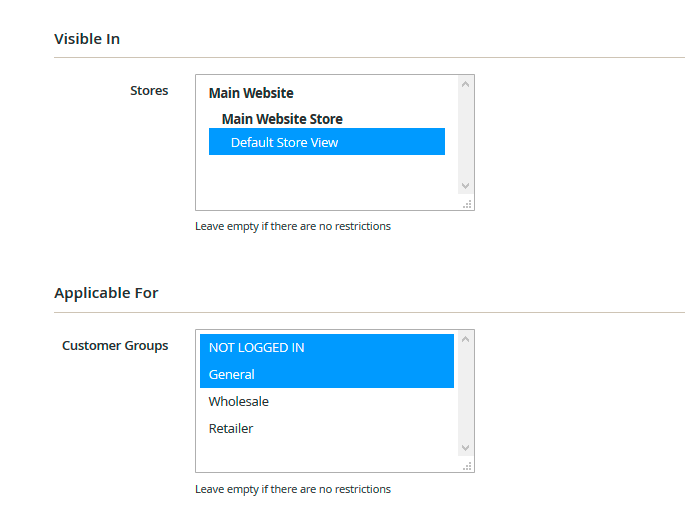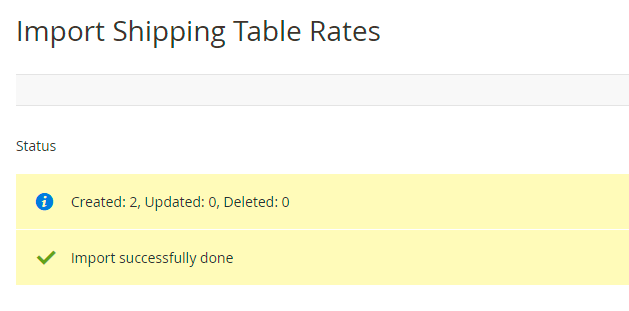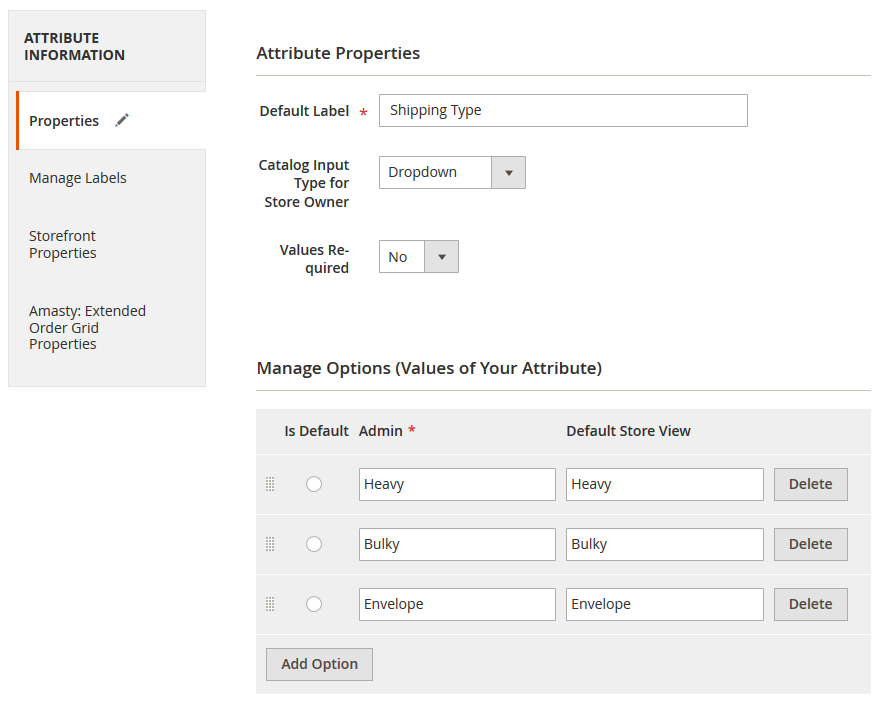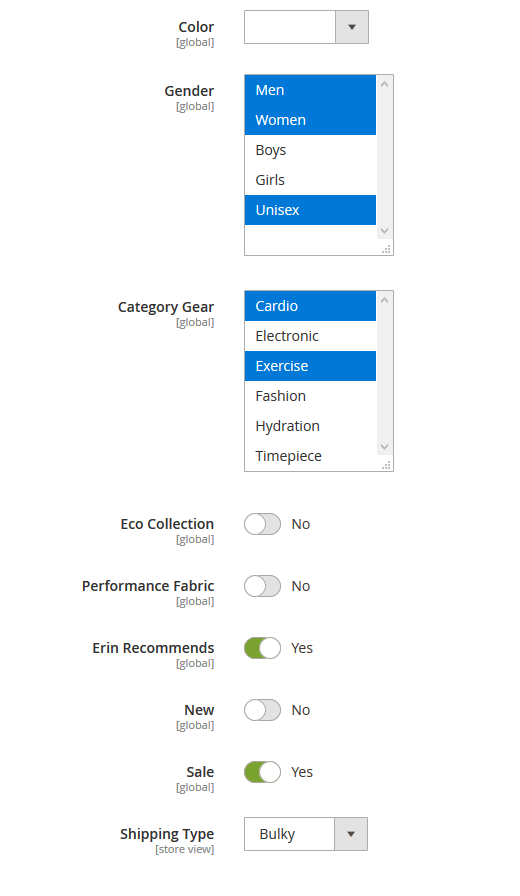User Tools
Site Tools
Sidebar
magento_2:shipping_table_rates
Table of Contents
For more details see how the Shipping Table Rates extension works.
Guide for Shipping Table Rates for Magento 2
Create an unlimited number of flexible shipping methods with individual rates. Use Magento 2 shipping table rates combinations of a destination address vs cart weight, order subtotal and price to accurately calculate delivery.
- Generate multiple custom shipping methods
- Create specific costs for any product or a product group
- Quickly import shipping table rates to Magento or edit them manually
- Show estimated delivery time for each created method
- Display comments and images on product and checkout pages
- Rest API support
- Complies with Hyvä & Hyvä Checkout Content Security Policy
Magento 2 Shipping Table Rates extension is compatible with Hyvä themes. You can find the 'amasty/module-shipping-table-rates-hyva' package for installing in composer suggest (Note: the compatibility is available as part of an active product subscription or Support Subscription). The extension is also working properly with Hyvä Checkout.
This extension is compatible with Hyvä Checkout and Hyvä Checkout Content Security Policy. You can find the 'amasty/module-shipping-table-rates-hyva-checkout' package for installing in composer suggest (Note: the compatibility is available as a part of an active product subscription or support subscription)
Magento 2 Shipping Table Rates extension is compatible with GraphQL Application Server. You can find the amasty/module-graphql-application-server-compatibility package for installing in composer suggest.
![]() Any concerns about module configuration and implementation?
Any concerns about module configuration and implementation?
Book an individual training session to explore how the extension works and what practices to implement to achieve the desired result. Save time spent searching for the right settings - discuss configuration cases suitable for your business with the experts and work out the flow that your team needs.
In Shipping Table Rates FAQ you can find answers to the most popular questions about the extension functionality.
Now you can generate ideal shipping rates and feel a great benefit.
Interested? See how the “Shipping Table Rates for Magento 2” extension works.
1. The extension creates a specific carrier (named by default Shipping Table Rates).
2. The carrier contains shipping methods with different shipping rates. The number of possible shipping methods, as well as the number of shipping rates, are not limited.
3. Each rate is configurable - you can choose conditions of its application. Available conditions are Country, State, City, Zip Code, Quantity, Weight, Price, Shipping Type.
4. You can also set various rates' types:
- a Base Rate for the Order;
- a Percentage per Product;
- a Fixed Rate per Product;
- a Fixed Rate per 1 unit of weight;
5. Calculates the rates for the order and displays to customers the available delivery methods.
Still not clear what cases does the extension cover? Let's see the example.
You deliver kids toys to the Netherlands and Poland. To the Netherlands - by train and by airlines, to Poland - only by train (these are your shipping methods).
The shipping method is the way of physical relocation of products. You can ship the order to a customer located in the Netherlands either by train or by airlines. But you can not combine the methods for the same order!
You've set up the next shipping rates for each method:
1) The Netherlands, train (15 days delivery):
- 10% of the order amount;
2) The Netherlands, airlines (3 days delivery):
- $25 for the order (the weight is less than 5 kilos);
- $35 for the order (the weight equals or greater than 5 kilos, but does not exceed 15 kilos).
3) Poland, train (7 days delivery):
- $15 for the order (the quantity is less than 15 items);
- $20 for the order (the quantity equals or greater than 15 items);
This is how the mentioned conditions will be displayed in the table of the Shipping Table Rates:




This is how the shipping rates will be displayed to different customers:

Due to the extension, you can bring to life boundless ideas of rates application:
- set fixed rates per each product in the cart;
- set percent rates;
- specify special rates for particular products or product categories;
- use volumetric attributes and others.
Thoroughly explore the possibilities of Shipping Table Rates for Magento 2 extension with the user guide.
Usage Examples
1. Elementary example: free shipping for any order
Let us start with a quick example: we just set a zero shipping cost regardless of the products in the cart.
To achieve this we create a method with a single rate:

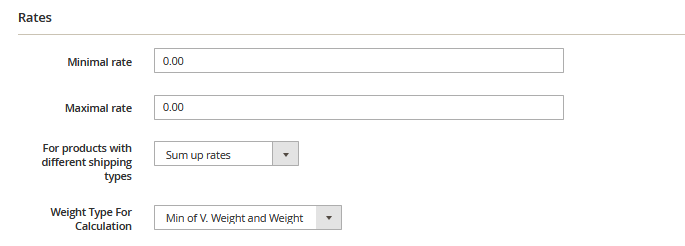

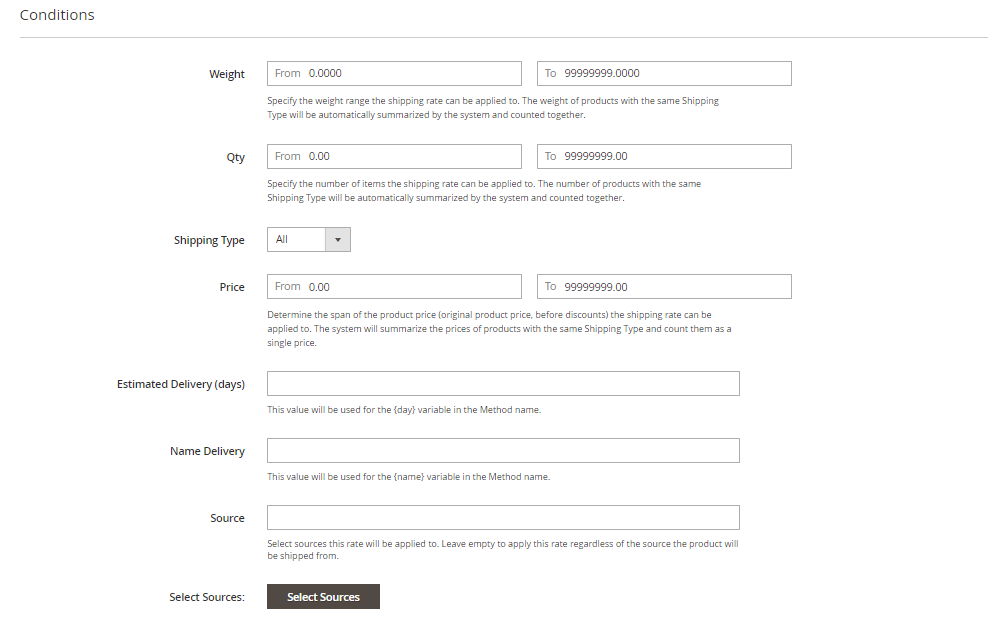
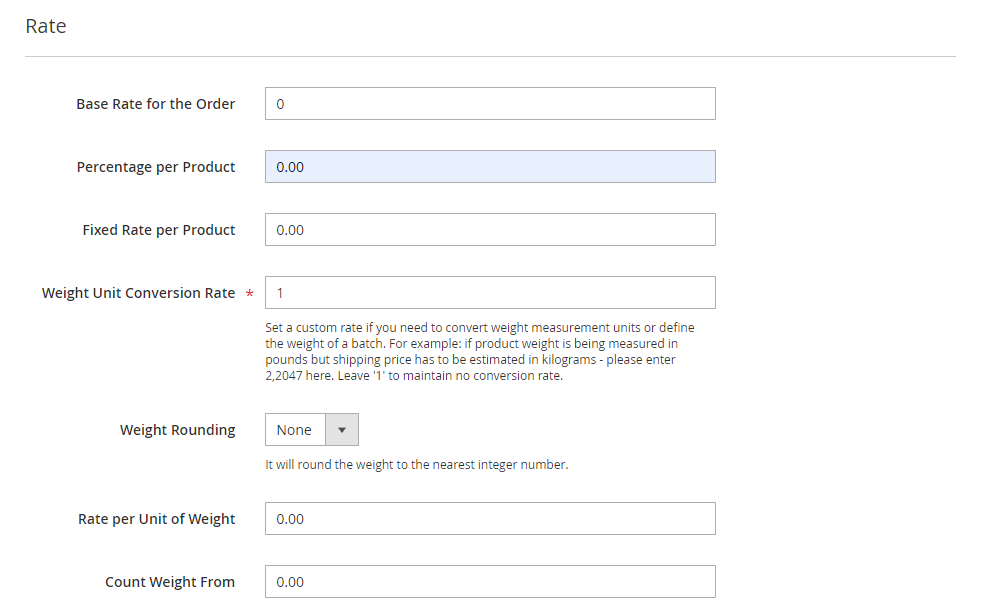

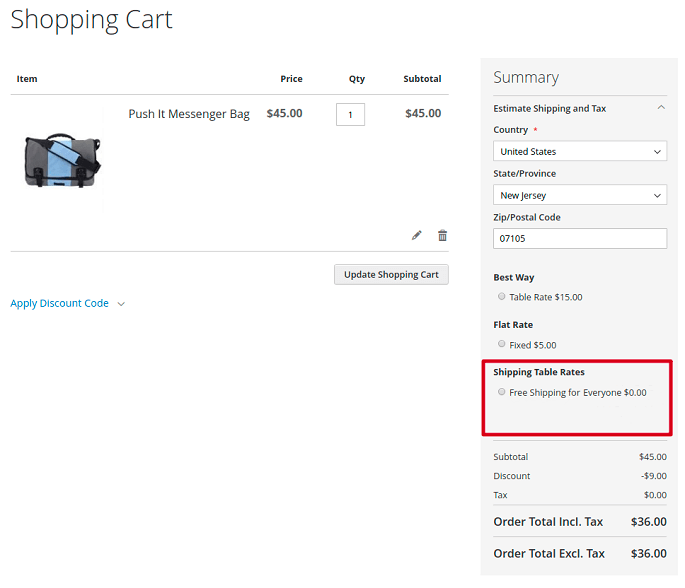
2. Flat rates
Magento out of the box has Flat Rate shipping. It allows the setting of a fixed price per item or per order. Amasty Shipping Table Rates allows to cover and extend this functionality.
Cost per order is set in the “Base Rate for the Order” field.


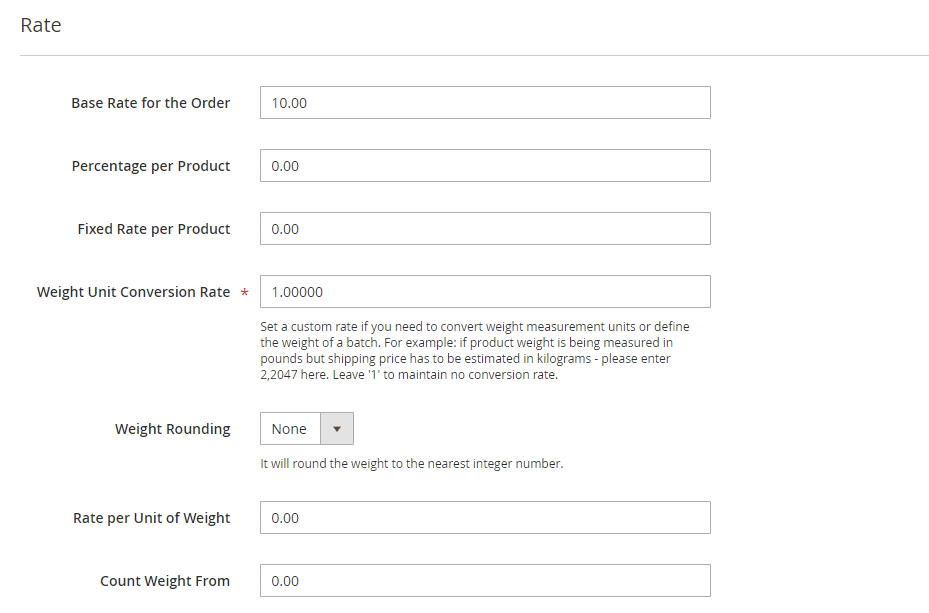
On the frontend, it does not depend on cart entries. If we add more products to cart, it'll remain unchanged.
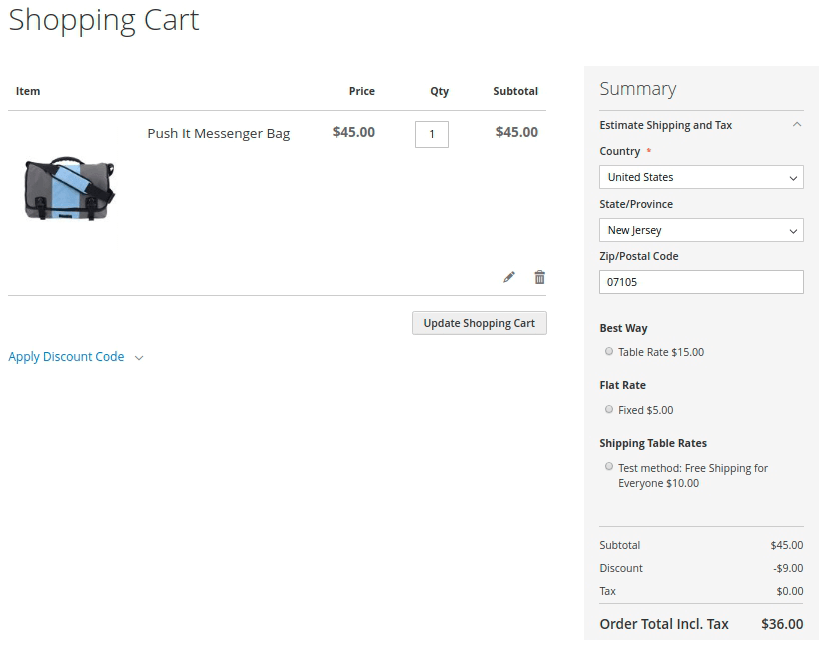
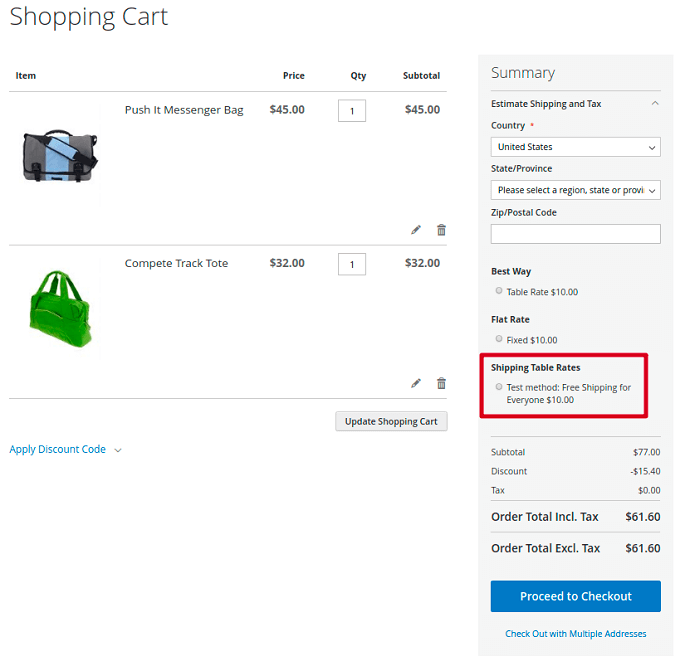
“Rate per product” is added for each item:


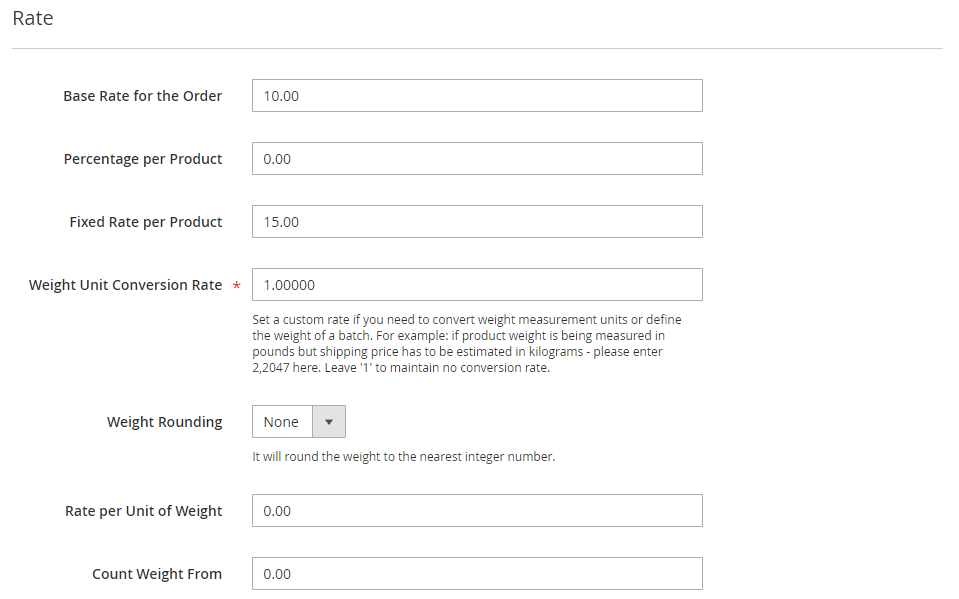
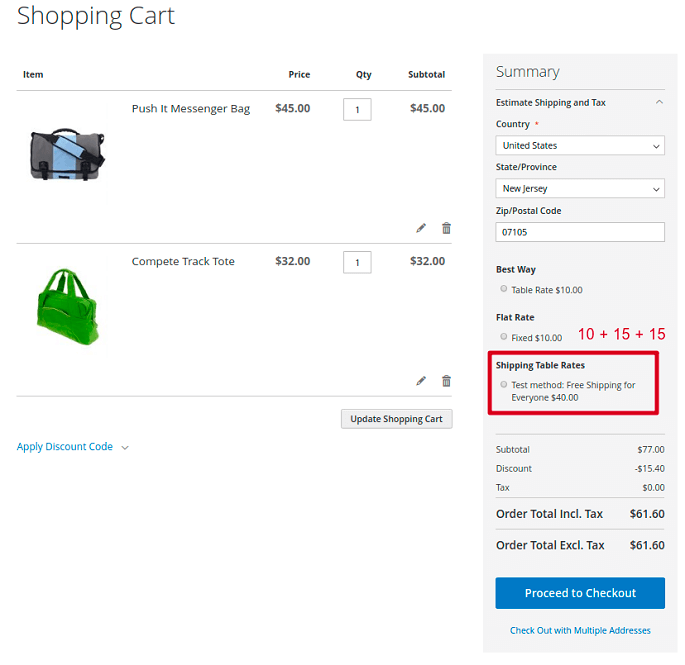
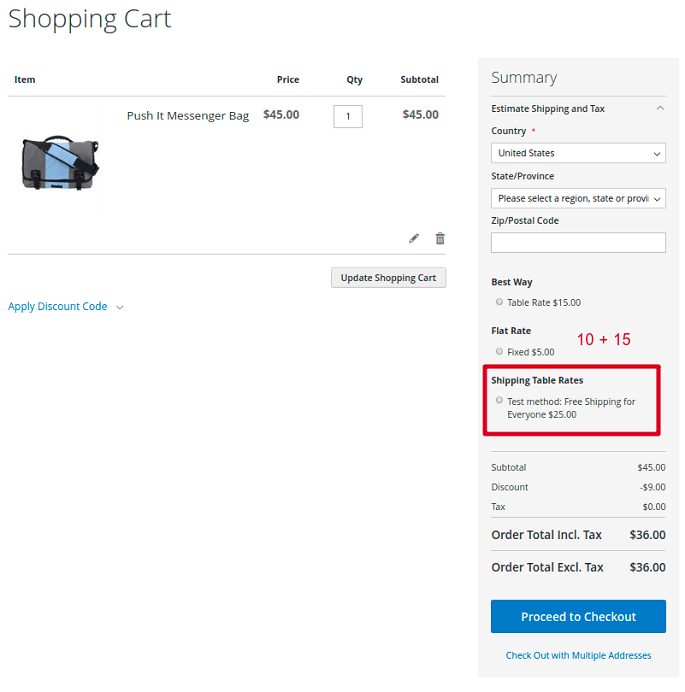
“Rate per unit of weight” is added for each lbs/kg:
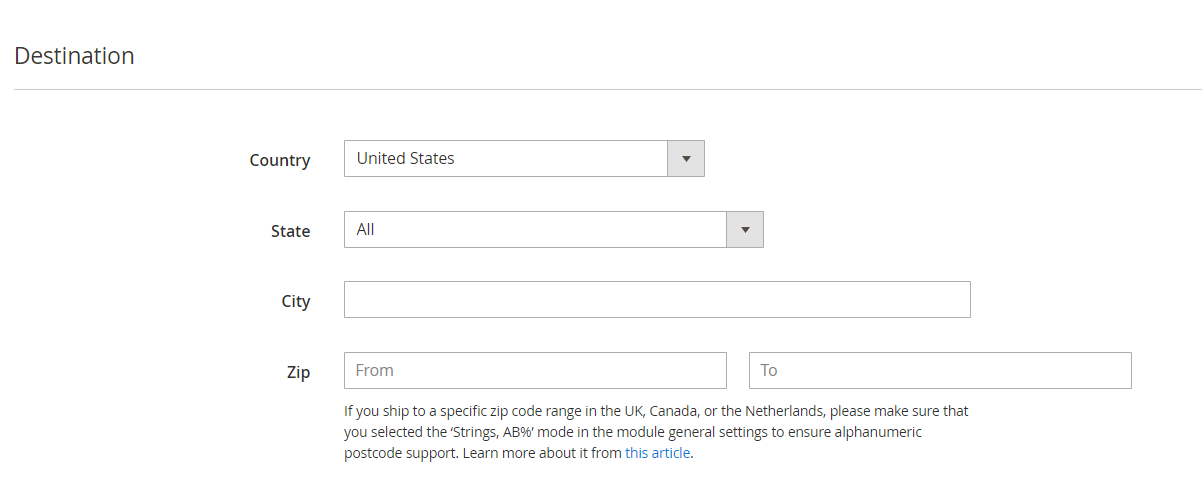
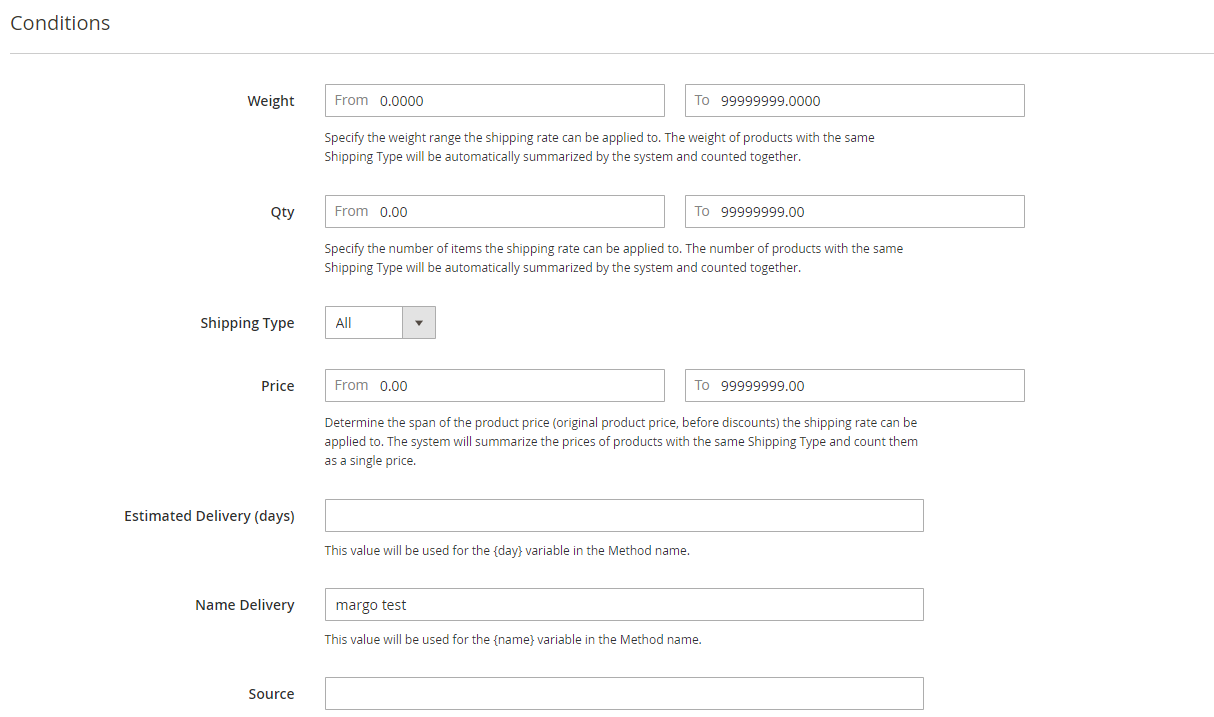
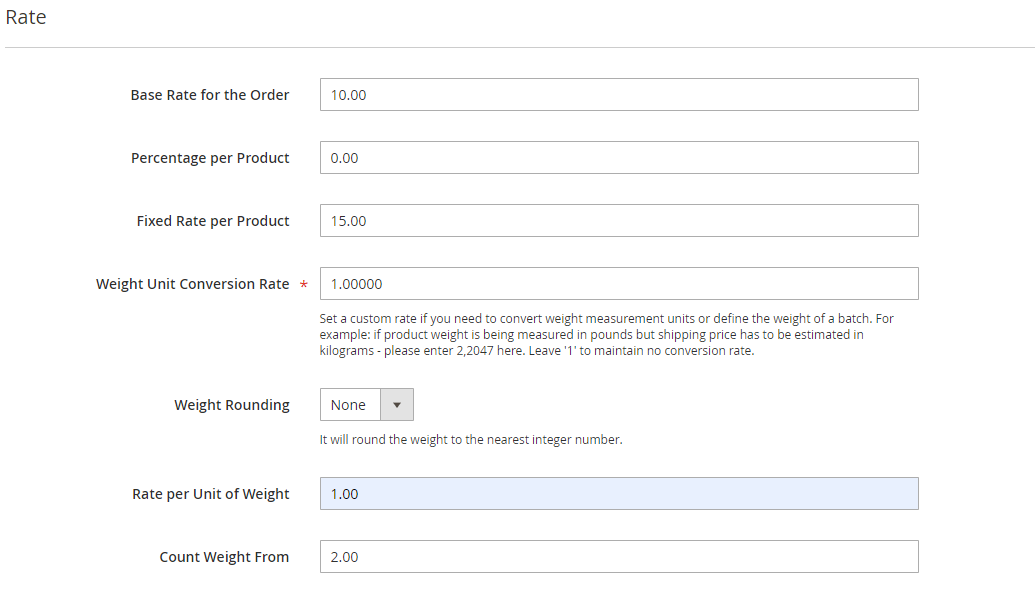 Count weight from - adjust this to set 'Fixed Rate per 1 unit of weight' to apply only if the weight is heavier than specified. In case you want to apply the rate per unit of weight to any weight, set this option to 0.
Count weight from - adjust this to set 'Fixed Rate per 1 unit of weight' to apply only if the weight is heavier than specified. In case you want to apply the rate per unit of weight to any weight, set this option to 0.
“Percentage per Product” makes shipping cost connected to products price:




3. Areas
Shipping cost may be based on delivery area. The name of the area can be shown using {day} variable.
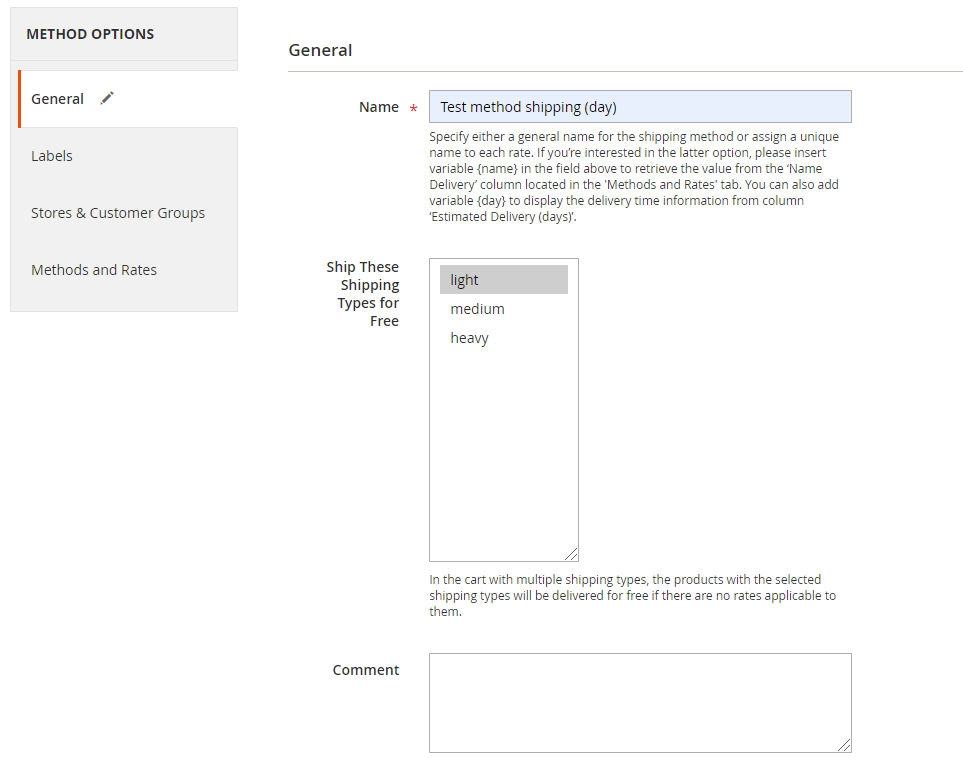

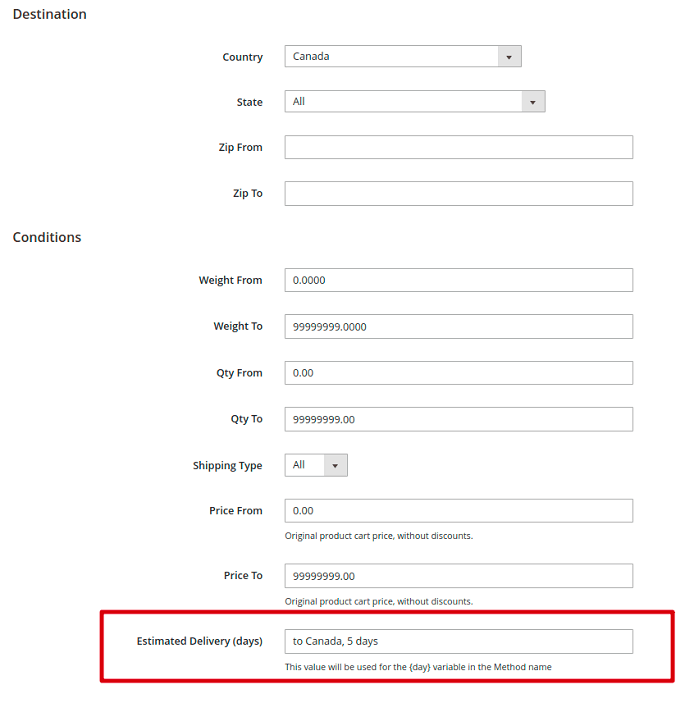
The method’s title differs according to the location.
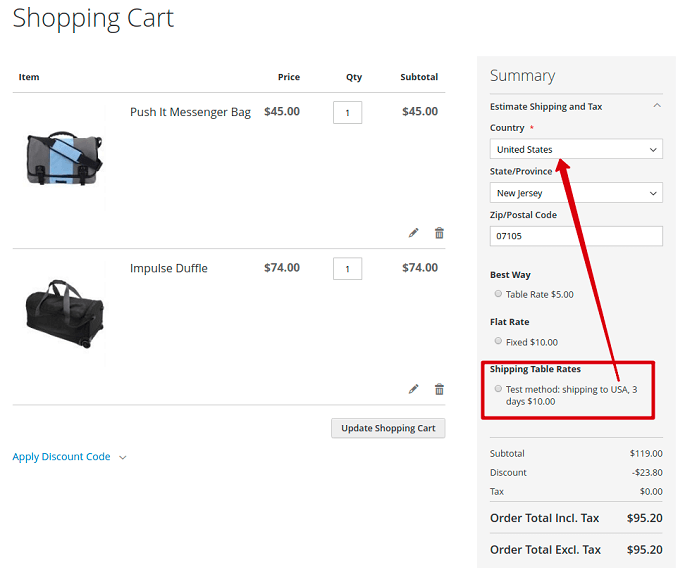
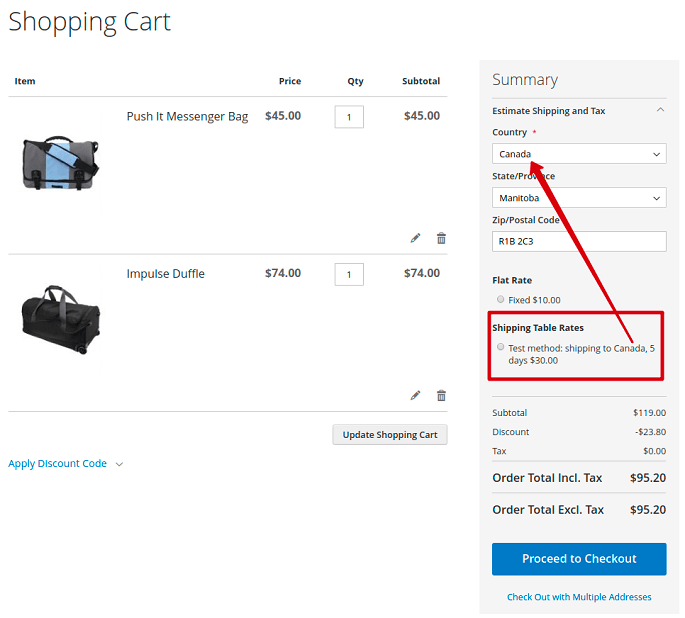
4. Tiniest match rule
Sometimes, we see that more than one rate can be applied simultaneously.
For example, there are two rates: a rate for all countries and a rate for USA only.


Respectively, it is a bit ambiguous what rate should be loaded for USA orders. Some people expect that we will see two methods on the storefront.
If two methods are applicable, the extension checks for the tiniest match. In our case, “Country = USA” is closer than “County = Any”, so the USA rate will be loaded.
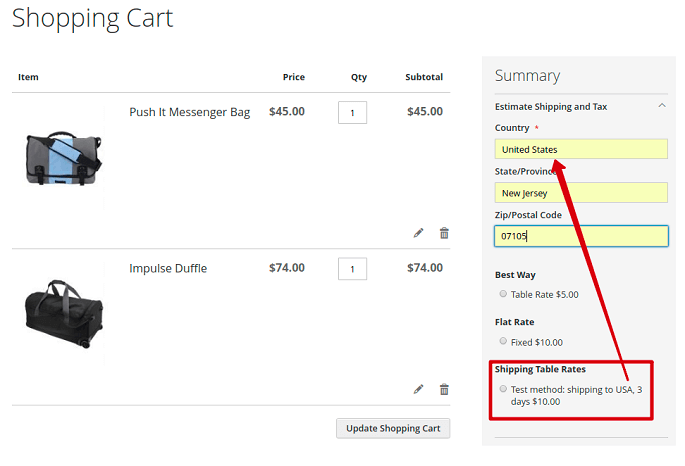
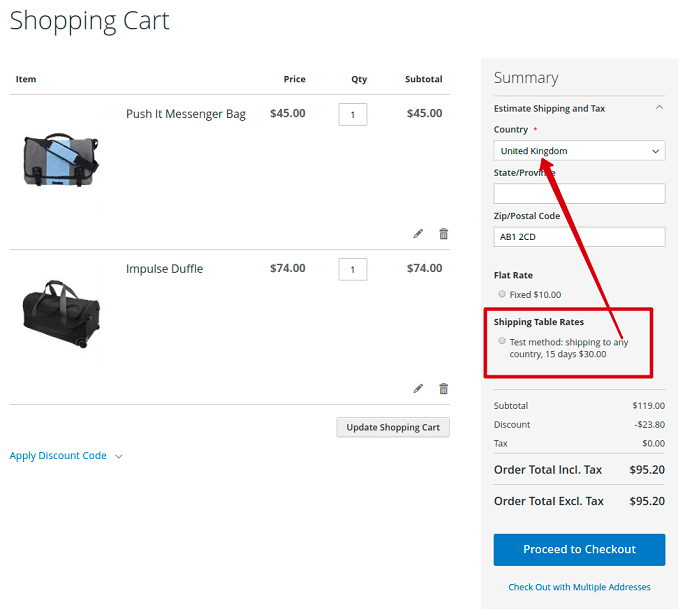
If you need both options to be displayed, you are to create two separate shipping methods.
The same applies to states and ZIP-codes. To learn more about it, please, check this article: blog post.
Magento 2 Shipping Table Rates is compatible with Multi Address Checkout. Thus you can enable your customers to ship an order to multiple addresses during checkout, and determine the maximum number of addresses to which an order can be shipped.
5. Combining rates with shipping types
Oftentimes, you have different rates for different products. For example, you divide your catalogue by weight, price, category or any other key feature. For these cases, it is handy to use shipping types.
Shipping type is a product attribute which is added by Amasty Shipping Table Rates. Values of this attribute can be set in Admin panel > Stores > Attributes > Product > am_shipping_type.

If types are created, they can be assigned to products:
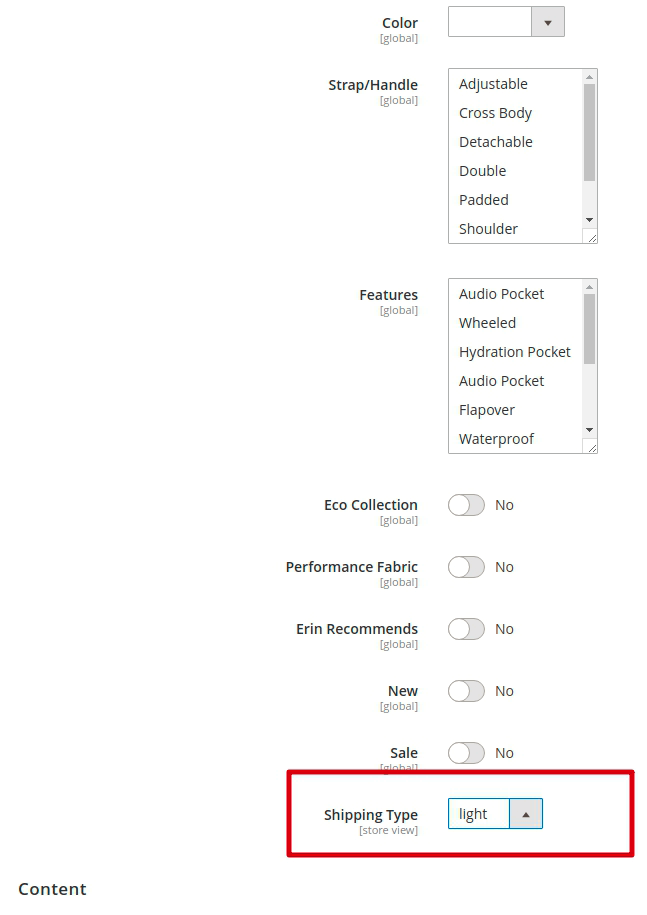
When shipping types are assigned to products, products in the cart are grouped by them. Each of these groups may have its own rate.
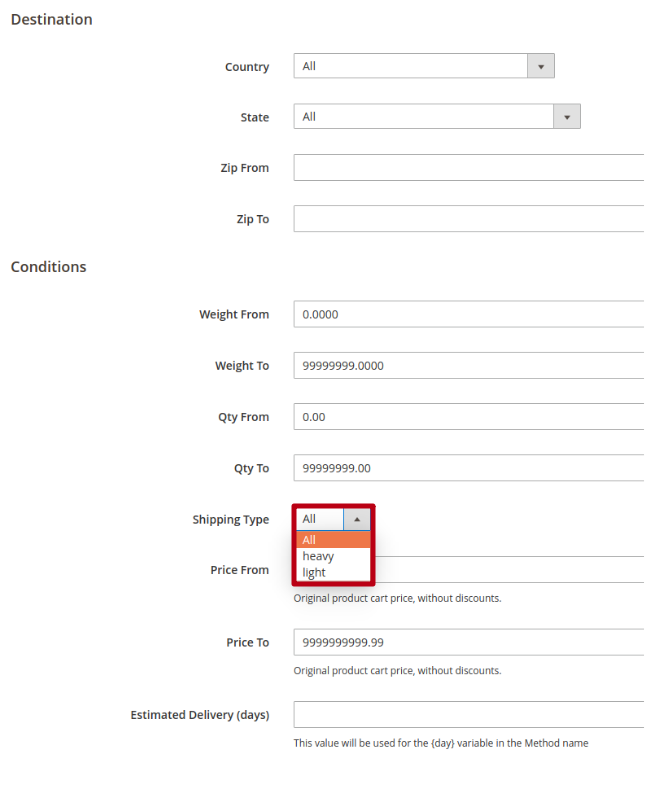
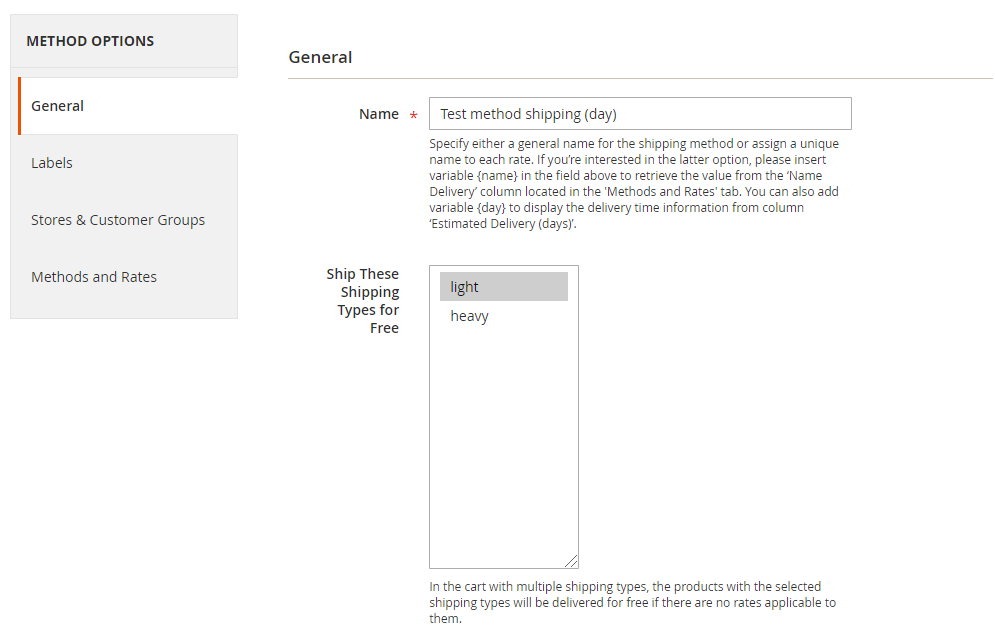

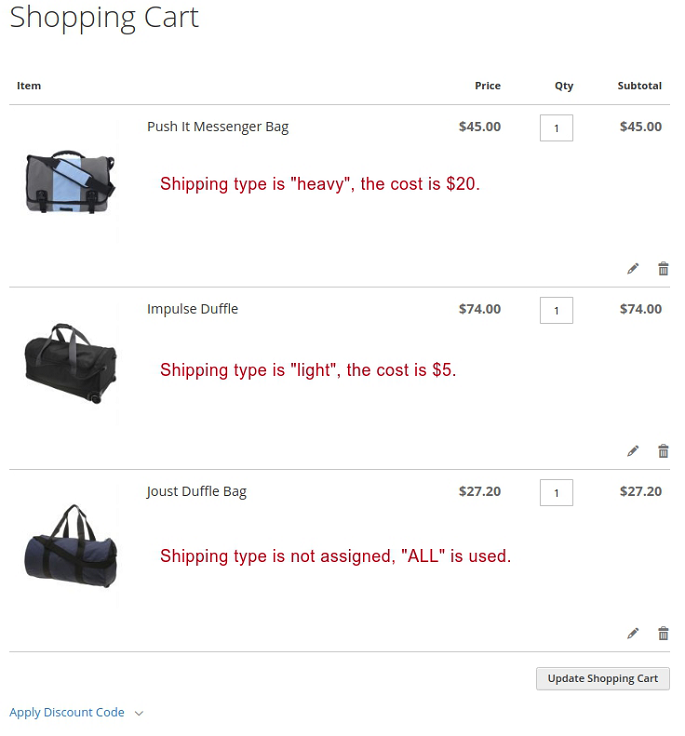
When we deal with a mixed-type card, it is not defined explicitly what rate should be used. Store managers can resolve the issue by configuring the extension and its rates.
According to the tiniest math rule, if there is a rate for all shipping types and a rate for a specific one, the later is chosen. That is why we have a number of applicable rates. We can use the minimum, the maximum one, or the sum of rates.
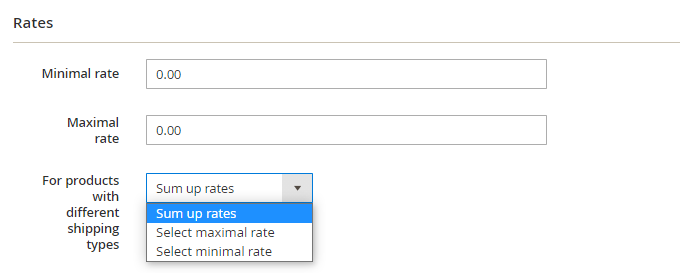
The most common case is “Sum up rates”:

In the Rates tab, you can also choose the weight type to use in calculations:
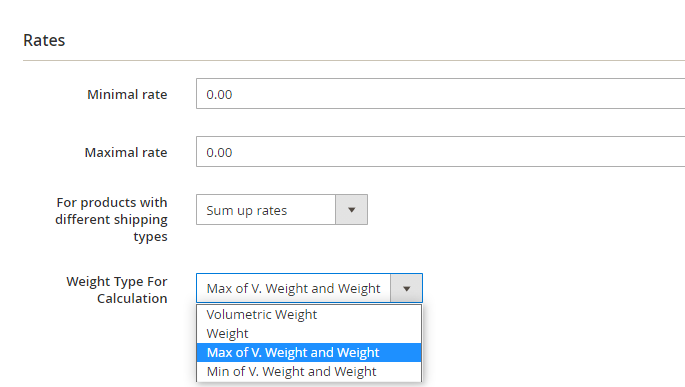
For the correct work of this option, you should preliminary add volume weight attribute to your products, and then fill in the values for products' Weight and Volume Weight.

You can find more information about these settings in the Shipping Method Settings section of this guide.
Also, it is possible to disable grouping products by shipping type. For that, please go to Admin panel > System > Configuration > Sales > Shipping Methods > Shipping Table Rates > Use only one shipping type for shipping method.

When this option is enabled, the mixed-type card may use rates for “All” shipping type only. For example:

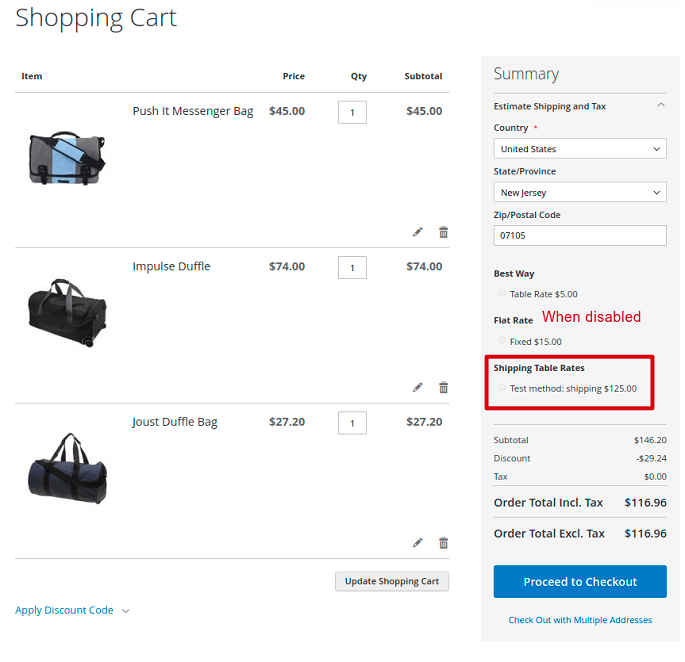

General Settings
To configure general settings, go to Stores → Configuration → Shipping Methods →Amasty Shipping Table Rates
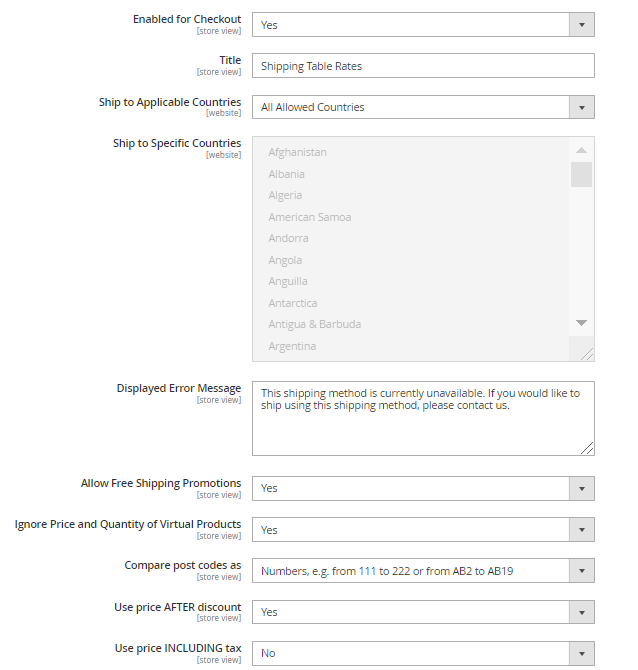
- Enabled for Checkout - specify if a shipping carrier should be available in the store view.
- Title - the shipping carrier’s name, which will be displayed above the list of its shipping methods.
Please note if the shipping carrier’s name is removed, the checkout page will display only the selected delivery method's name, without mentioning the courier service.
- Ship to applicable countries - define if the shipping methods of the carrier are allowed to all countries or to the specific ones.
- Ship to Specific countries - choose the countries to which the shipping by the carrier is available. The option becomes active only when the Ship to applicable countries setting is set to Specific Countries.
- Displayed Error Message - specify the error message that will be displayed to customers when shipping methods of the carrier are not available.
- Allow Free Shipping Promotions - enable if you want Free Shipping from Shopping Cart Price Rules to be applied to the shipping methods of the carrier.
- Ignore Price and Quantity of Virtual Products - enable the option to exclude Virtual products' quantity and price from the rates calculations based on Price and Quantity conditions.
- Compare postcodes as: - choose one of the available modes to specify the postcodes’ format: Numbers mode or Strings mode. Please check the blog post for more information on postcodes processing.
- Use price AFTER discount - enable to use the prices after discounts application for rates generation.
- Use price INCLUDING tax - choose which prices should be used for the generation of rates: including tax/VAT or without tax/VAT.
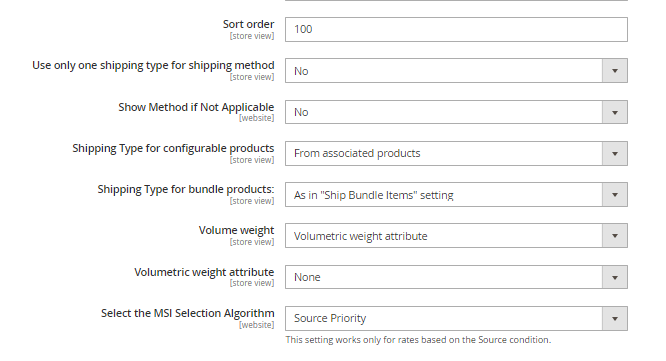
- Sort order - determine the place of a Table Rate carrier in the list of shipping carriers. To place a carrier on the top of the list, the value '0' should be specified.
- Use only one shipping type for shipping method - enable to apply the Shipping Type “All” to carts containing products with different shipping types. This means, that the option limits the application of different rates to the one cart. When the cart contains products with different shipping types, the rate with the Shipping Type “All” will be applied.
- Show Method if Not Applicable - set to Yes to show to customers the methods, when they are not applicable. The error message will inform the customers about the unavailability of the methods displayed.
- Shipping Type for bundle products - the option controls which shipping types will be assigned to bundle products. When it is set to As in Ship Bundle Items setting, the system will check the mentioned setting in a bundle product configuration settings. When set to From bundle product, the shipping type assigned to bundle products will be used. If set to From items in the bundle, shipping types assigned to each product in the bundle will be used.
Two values are available for the Ship Bundle Items setting: Together and Separately. When the value Together is chosen, the Shipping Type will be taken from a bundle product. When the setting is set to Separately, the Shipping Type will be taken from simple products contained in the bundle.
- Shipping Type for configurable products - the option controls which shipping types will be assigned to configurable products. Set to From associated products or From parent product to take the Shipping Type value from associated simple products or from a parent configurable product accordingly.
- Volume weight - choose the way to calculate a shipping rate based on a volumetric weight:
- Volumetric weight attribute - choose the option to use the already calculated volumetric weight value. You need to create a volumetric weight attribute and specify its value for the items manually.
- Volume attribute - when choosing this option, the volumetric weight will be calculated based on the item's volume and shipping factor. You need to create a volume attribute, specify its value for the items and also set a shipping factor (use the DIM Factor published by your courier company to establish the dimensional weight).
- Dimensions attribute - choose the option to make the volumetric weight to be calculated based on the item's dimensions. To use this option, you need to create a dimension attribute, specify its value for the items and determine the shipping factor (Use the DIM Factor published by your courier company to establish the dimensional weight).
- Separate dimension attribute - choose this option in case you have the attributes for each particular dimensions parameter (height*length*width). Specify the shipping factor as well (Use the DIM Factor published by your courier company to establish the dimensional weight).
For more information about volume weight calculation methods, please go to the Volume weight settings section.
- Select the MSI Selection Algorithm - define the MSI algorithm that will be used for Source selection in the cart by default. It works only for rates with the specified Source condition.
Shipping Method Settings
General Settings & Rates
To configure shipping methods settings please go to Sales > Amasty Shipping Table Rates
You can both create a new shipping method or correct the existing ones. To edit one of the already created shipping methods, just click on the necessary one in the table. To create a new method, click the Add New button.

Name - give a name to a shipping method that will be shown to customers in the list of available shipping methods (both on the checkout and in the cart).
To provide customers with more complete information, specify the {day} variable in the Name field. This variable will draw the information from the Estimated Delivery (days) column of the table, provided on the Methods & Rates tab. You can also specify the “delivery name” value for the {name} variable on the Rate Configuration page.
Available variables
A quick example:
1) Specify the Name of the method using the {day} variable on Sales > Amasty Shipping Table Rates. This is how it should look like on the backend:

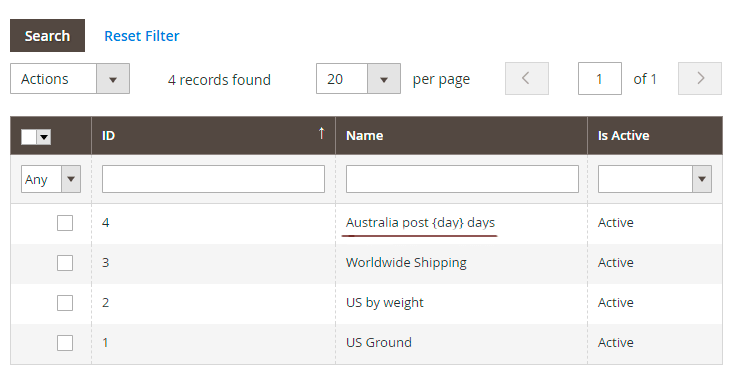
2) Determine the number of delivery days in the table, located at the Methods & Rates tab.

3) Now check, how the method will be displayed to customers on the frontend - the {day} variable takes the information from the Estimated Delivery (days) column of the table:

Subsription only! We have added the {interval} variable, which allows to specify the delivery interval in the method. When you use a new variable in the method name, the interval calculated based on the value from Estimated Delivery (days). The interval value is calculated using the example: “tomorrow - the day after tomorrow + the number of specified days” (if today is December 7 and 5 days are specified in Estimated Delivery (days), then the method will display “December 8 - December 13”). This functionality works based on the store's locale, not the customer's locale. Look at the example on the storefront:


Ship These Shipping Types for Free - the products of the selected shipping types will be sent for free if there are no other applicable shipping rates within the method configured for this type. Note, that the setting will be applied only if the order contains the products of other shipping types, besides the selected ones.
In case the cart contains only one product with the specified Shipping Type, the shipping method won't be displayed to customers until you complete either of these actions:
- set a special shipping rate for the mentioned Shipping Type
- set a rate for the Shipping Type = “All”.
Comment - fill in this field if you want to leave some extra information to customers. The text will be shown on the checkout page and in the cart (under the shipping method’s name). Use HTML tags if needed. You can also upload an image to the shipping method and insert the {IMG} variable anywhere you want in the Comment field.
Status - indicate the shipping method as active or not.
Priority - specify the priority of displaying the method on the Shopping Cart/Checkout pages. The table rates will be sorted according to the rate's Priority: the lower value in the Priority field, the higher the method on the storefront.

Minimal rate - define the lowest possible value of a rate.
Maximal rate - specify the maximum possible value of a rate.
For products with different shipping types - choose the way the rates will be calculated for products with different shipping types.
- Sum up rates - summarizes the shipping rates of products with different Shipping Types. It means that the total shipping rate for the order will constitute the sum of individual rates for every Shipping Type in the cart. Keep in mind, that the rates will be summed up only when they are set up for the same shipping method;
- Select maximal\minimal rate - compares rates of particular Shipping Types of products in the cart, and selects the maximal/ minimal rate as a total shipping rate for the order.
For more information please go to the Shipping Type section.
Weight Type For Calculation - in this tab, you can strictly set up which type of weight should be used for shipping price calculation for specific shipping methods and products. You can choose one of the four options:
- Volumetric Weight - the extension will use volumetric weight for the calculations.
- Weight - the extension will use actual weight for the calculations.
- Max of Volumetric Weight and Weight - the extension will compare the weight of the product to its volumetric weight and choose the greater value.
- Min of Volumetric Weight and Weight - the extension will compare the weight of the product to its volumetric weight and choose the minimal value.
For the correct work of the setting, please make sure, that you have filled in the products' weight and volumetric weight in the products' settings.
Labels
On this tab, you can create specific Labels for every store view you manage. Fill in the Method Label field at first. Then provide some extra information about the method, by filling the Comment field.
.
Stores & Customer Groups
Stores - determine the stores, in which the shipping method should be visible to customers.
Customer Groups - define customer groups, to which the shipping method will be available.
Methods & Rates
By subscription only! We have added a feature that allows you to import countries in a single line, separated, for example, by a comma (depends on how it is defined in the “Multiple Value Separator” settings for importing files). Thus, a separate rate with the specified values will be created for each country from the row.
Country - define the country to which the shipping rate is available.
State - choose the State to which the shipping rate should be applied.
City – specify the city to which the rate will be applied.
Zip From - To - define a range of postcodes or a particular postcode to which the shipping rate will be applied. To specify a single specific postcode, fill in only the Zip From field or both fields – Zip From and Zip To with the same value. The shipping rate will be applied to all the postcodes within the specified postcode range.
Price From - To - determine the span of products price to which the shipping rate should be applied. The system will summarize the prices of products with the same Shipping Type and count them as a single price.
Weight From - To - specify the weight diapason to which the shipping rate will be applied. The weight of products with the same Shipping Type will be automatically summarized by the system and counted as a single general weight as well.
Qty From - To - determine the diapason of products quantity to which the shipping rate will be available.
Shipping Type - specify to products of which shipping type the method should be applied. Please go to the Shipping Type section to get more information.
Price - specify the number of items the shipping rate can be applied to. The number of products with the same Shipping Type will be automatically summarized by the system and counted together.
Estimated Delivery (days) - specify the number of days the delivery will take. The information from this column will be inserted in the {day} variable used in the Name field.
Name Delivery - this value will be used for the {name} variable in the Method name.
Source - specify the Source(s) to which the shipping rate will be applied. Leave empty to apply this rate regardless of the source the product will be shipped from. On the checkout, sources will be automatically picked by the algorithm specified in Select the MSI Selection Algorithm setting. Please, note that setting particular sources for the rate may impact the website’s performance.
Base Rate for the Order - specify the shipping rate for the order.
PPP (Percentage per Product rate) – fill the field if you want the shipping rate to be calculated as a percentage of the products price.
FRPP (Fixed Rate Per Product) – define a fixed shipping rate per product. The total shipping rate for the order will be calculated by multiplying the mentioned fixed shipping rate on the number of products in the cart.
Weight Unit Conversion Rate - set a custom rate if you need to convert weight measurement units or define the weight of a batch. For example: if product weight is being measured in pounds but shipping price has to be estimated in kilograms - please enter 2.2047 here. Leave '1' to maintain no conversion rate.
Weight Rounding - specify the desirable type of rounding for the total cart weight if necessary (works with Fixed Rate per Unit of Weight only).
FRPUW (Fixed Rate per Unit of Weight) – specify a fixed rate which will be multiplied on a weight of products in the cart to get the total shipping rate for the order.
Count weight from - set 'Fixed Rate per 1 unit of weight' to apply only if the weight is heavier than specified in this configuration.
Rest API support
The extension allows you to get shipping table rates, select the shipping method and place the order with one via REST API.
Import
Due to the functionality that relies on Magento Import component, it is possible to seamlessly import
huge data volumes just in a few clicks.
Proceed to System → Import Shipping Table Rates.
 In the Import Settings tab, you can upload a CSV sample file. Click hereamstrates_rate_import_.zip to download it from the guide.
In the Import Behaviour tab, please choose the needed behaviour type:
In the Import Settings tab, you can upload a CSV sample file. Click hereamstrates_rate_import_.zip to download it from the guide.
In the Import Behaviour tab, please choose the needed behaviour type:
- Add - keeps rates that are present in both selected shipping methods and the file you provided;
keeps rates that are present in selected shipping method but are missing from the file you provided; adds rates that are not available in selected shipping method but are present in the file you provided.
- Replace - this option replaces ALL rates in the selected shipping method with the rates you
provided in a file. Firstly, all the existing rates for the selected method will be removed, and then the new ones from your import file will be uploaded.
- Delete - removes rates you provided in a file from the selected shipping method.
For the Add and Delete import behaviour types, the extension performs an on-the-fly comparison of whether there are such rates in the selected shipping method.
In the Validation Strategy tab, you can choose whether to Stop on Error or Skip error entries.
Specify the number of errors to halt the import process in the Allowed Errors Count field.
Provide Field separator, Multiple value separator, Empty attribute value constant and enable
Fields enclosure if needed.

- Shipping Table Rate Method - select the method to which the import actions will be applied. We
have also added the ID number for each method. It is especially useful if the list contains the shipping methods with the same name.
Subscription only! We've added the import functionality to include countries in a single line, separated by a designated that is defined in the Multiple Value Separator setting for file imports. Thus, a separate rate will be created for each country from the row with the specified values.
Choose the file to import.
File must be saved in UTF-8 encoding for proper import.
After the file is added, hit the Check Data button to validate the document and see if there are any
mistakes.

If everything is correct, click Import to add, replace or delete new rates.
Rate Configuration
Specify conditions for each particular shipping rate application.
All the fields of Rate configuration are described at the Methods and Rates section.
Shipping Type
'Shipping Type' is a special product attribute. You can apply different shipping rates to the products in the cart, depending on the value of the Shipping Type they have. The default value of a Shipping Type is “All” - it is applied to all products. The principles of the Shipping Type setup in Magento 2 are identical to the ones in Magento 1.
Please check the blog post to see the examples of how the Shipping Type works.
Create options for the ‘Shipping Type’ product attribute at Stores > Attributes > Product.
You can assign Shipping Types you’ve created to the products on the product editing page.
When the cart contains products with a particular Shipping Type, shipping rates related to the mentioned Shipping Type will be applied. If no shipping rates are specified to the Shipping Type, the rates with the Shipping Type “All” will be applied.
Volume weight settings
The Volumetric or dimensional weight is a pricing method which helps a carrier to organize the most efficient usage of the cargo space.
Dimensional weight is calculated as (length × width × height of a package) / (dimensional factor).
The shipping factor (DIM) is a number a carrier uses to reach the effective weight of a shipment based on its density. Basically, the dimensional factor is the amount of space the package takes up per pound. If a Volumetric Weight is assigned to the product, the extension compares it with a regular product Weight and choose the biggest value for using in calculations. Use the DIM Factor published by your courier company to establish the dimensional weight.
For example, we’re shipping 10 pounds of bricks which can easily fit into a 10x10x10 box, making the volume of the box 1 000 cubic inches. When the cubic inches will be divided by the dimensional factor equal 166, the dimensional weight will constitute about 6 pounds. The charge will be rounded up to the 10-pound rate as for the dimensional weight is lower than the actual weight.
Let's consider the feature in details.
'Volumetric weight attribute' calculation method

- Volume weight - set to Volumetric weight attribute.
- Volumetric weight attribute - choose one of the volumetric weight attributes you've created earlier.
How to create an attribute?
1. Go to Stores > Attributes > Product > Add New Product Attribute and specify the attribute parameters.

2. Then go to Stores > Attributes > Product > Attribute Sets
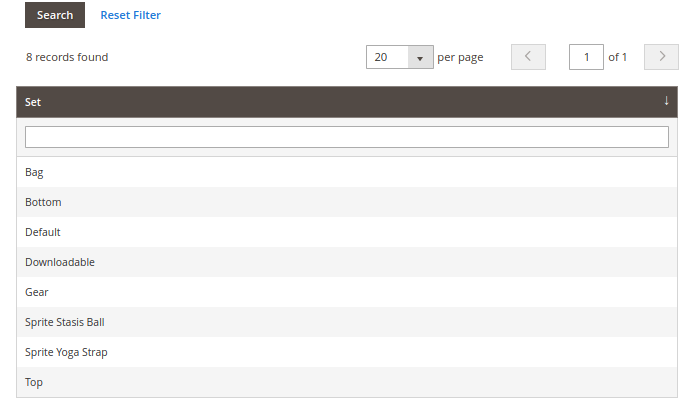
3. Choose the product category to which you would like to add a volume weight parameter (the Bag category in our example). Move the attribute you've created to the 'Groups' column, 'Product Details' group.

4. Go to Products > Catalog and choose a product to edit. In our case, it can be any bag. Specify the Volume Weight field with the required value to complete the setup.

'Volume attribute' calculation method

Volume weight - set to Volume attribute.
Attribute - choose the volume attribute created earlier.
Shipping Factor - specify the value of the DIM factor. Consult your courier company if needed.
'Dimensions attribute' calculation method
Volume weight - set to Dimensions attribute.
Dimensions attribute - choose the dimensions attribute you've created before.
The value of the dimensions attribute should be specified in the following format: height*width*length or it is also affordable to use “x” instead of “*”, for example, 12x45x34 or 16*27*33.

Shipping Factor - specify the value of the DIM factor.
'Separate dimensions attribute' calculation method
Volume weight - set to Dimensions attribute.
Attribute 1, Attribute 2 and Attribute 3 - choose the necessary attributes for volume parameters.
Shipping Factor - specify the value of the DIM factor.
How the rates are calculated
The shipping rates in a shipping method should be set up at first. Check the example below.

Note: the active conditions are Shipping Type, Quantity, and Country.
The example of a shopping cart.

At first, the rates for the products with defined Shipping Types will be applied. As the method contains the rate for the Shipping Type “heavy” and the cart contains a product with the same Shipping Type – “Body-Builder Weight Equipment”, this rate will be calculated first and will constitute $25.
Two other products have the Shipping Types that are not specified in the method being applied. The method will be available to the cart for the reason that it contains the rates for the Shipping Type “All” which will replace the rates of these two products.
The calculation of the rate for this group of products has the next algorithm:
- the products’attributes (Price, Quantity, and Weight) will be summarized;
- the system will compare the result with conditions set and apply the rate that matches all the requirements.
In our example we have the restrictions on the number of products with the Shipping Type “All”. As the cart contains 35 items with such Shipping Type, the rate $15 will match. The total rate equals to $40. Remember, that the active Country condition makes the shipping method available only to customers willing to ship products to Australia.
Troubleshooting checklist
If the Shipping Table Rates method you’ve created is not displayed:
- Check if the shipping carrier is enabled. To do this, please go to Stores > Configuration > Sales > Shipping Methods > Amasty Shipping Table Rates > Enabled for Checkout > Yes. Also, please check if the method you're willing to see at the Frontend is enabled: Sales > Operations > Shipping Table Rates.
- If the shipping carrier is enabled, but the method is still not visible, make sure that the shipping method contains all the rates related to the shipping types of products contained in the cart. To be displayed to customers, the shipping method should contain rates for all shipping types, that are found in the cart. Otherwise, the shipping method will not be visible. If the mentioned issue is a reason, the method will become available after adding a new rate with a Shipping Type “All” to the method.
If the For products with different shipping types field in the shipping methods settings is set to “Sum up rates”, but the rates don't sum up:
- Check if these rates belong to the same shipping method. If not, the rates will not be summed up as the setting, mentioned above, works only for the rates with different Shipping Types in the selfsame shipping method.
Additional packages (provided in composer suggestions)
To make additional functionality available, please install the suggested packages you may need.
Available for all tariff plans with no additional fees:
amasty/module-graphql-application-server-compatibility- Install this package for compatibility with GraphQL Application Server.
amasty/module-shipping-table-rates-msi-performance- Install this package to enhance compatibility with Magento Inventory.
Available as a part of an active product subscription or support subscription:
amasty/module-shipping-table-rates-hyva- Install module-shipping-table-rates-hyva module to activate the integration with Hyva Theme.
amasty/module-shipping-table-rates-hyva-checkout- Install this package to ensure compatibility between the Shipping Table Rates extension and the Hyva Checkout.
amasty/module-shipping-table-rates-subscription-functionality- Install this package for compatibility with subscription features like adding a new {interval} variable to display the delivery interval and ability to specify countries in one line in import files.
FAQ
* How do I specify estimated delivery time in the shipping method name?
* I'm having problems setting up Dimensional Shipping Weight. What should I check?
* How do I exclude postcodes while setting up shipping table rates?
* How do I set a different name for each rate within a shipping method?
* I have configured several shipping rates but only one is shown on the storefront. How to fix?
* How can I add a surcharge for particular rates?
Find out how to install the Shipping Table Rates for Magento 2 via Composer.
magento_2/shipping_table_rates.txt · Last modified: 2025/06/06 16:25 by avronskaya



